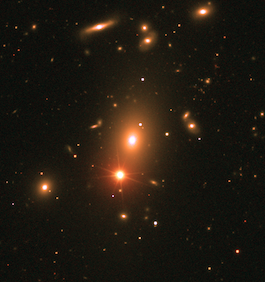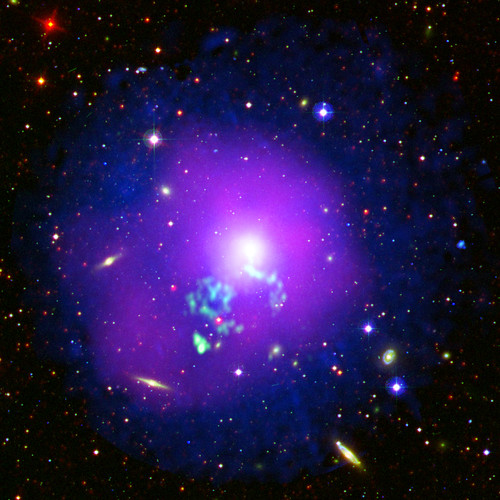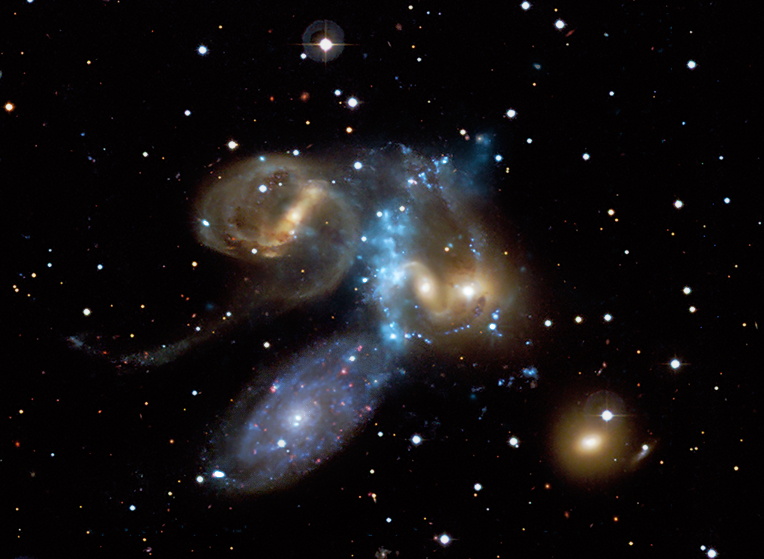Research Interests
In general terms my work focuses on the structure, formation, and evolution of galaxy groups. There are many things we don't fully understand about these systems: Galaxy groups are the environment in which most galaxies reside, but their properties vary hugely, from small associations of a handful of spiral galaxies to massive systems with several elliptical galaxies (themselves the product of galaxy mergers) and an extensive halo of hot gas containing more mass than all the galaxies combined. How groups evolve between these extremes, how they build their hot halos, and the feedback processes that prevent the gas cooling and forming stars, are all areas of active research.
AGN feedback in galaxy groups.
The last of these areas, feedback processes in galaxy groups, is central to a lot of my recent work. The hot gas in the cores of groups is dense enough to cool rapidly, but we do see only limited amounts of the products of such cooling, cold gas and young stars. There are various processes that could heat the gas, but at present it appears the most important is heating by the jets of relativistic plasma thrown out by the black holes in the centres of galaxies. These jets drive into the hot gas, causing shocks, and inflate bubbles which heat and lift the gas as they move through it. Investigating these processes requires excellent X-ray data, to see the hot gas, detailed radio observations at multiple frequencies, to see the jets and the plasma in the bubbles, and observations in other bands — millimeter-wave, optical, radio — to track the cold gas and star formation.

|
One example of AGN feedback is shown in the image to the left, the poor cluster AWM 4. This is a system of around 50 galaxies dominated by the giant elliptical NGC 6051. Using a combination of GMRT low-frequency radio data and a deep Chandra X-ray observation, we investigated the interaction between the 10 million K gas of the cluster halo (blue in the image) and the hundred thousand light-year long jets of relativistic particles (shown in red) thrown out by the black hole in the core of NGC 6051.
Chandra was able to resolve the small-scale cooling region in the core of NGC 6051 which fuels the black hole, and allowed us to measure the total energy released in the jets, about 1051 J, equivalent to the radiant output of the Milky Way over a million years. We were also able to examine the particle content of the radio lobes, and show that the jets have caused motions in the hot gas, lifting about a million solar masses of Iron out of the galaxy (where it had been deposited by supernovae) and mixing it into the halo. More detail can be found in two papers: the first describes the cool core, the properties of the radio jets and lobes, and the AGN energy output in AWM 4; the second focuses on the uplift of enriched gas by the radio jets.
Other areas of interest include:
Gas mixing and metal transport in X-ray bright groups

|
The image to the left shows the X-ray brightest group in the sky and its central dominant elliptical, NGC 5044. Using a deep XMM-Newton X-ray observation, we image the hot gas bound in the gravitational well of the group (shown in blue) and mapped the distribution of heavy elements in that gas (primarily Iron, shown in purple). Previous studies had shown that the gas in this group is sloshing, oscillating around its gravitational centre. Our maps shows that this motion has left a spiral trail of metal-enriched gas; the larger purple region in the centre and upper right is the central clump of enriched gas around the elliptical, while the clump to the lower left is the spiral trail viewed end-on. As well as transporting these metals out of the group core, the sloshing motion has influenced an old radio jet and lobe (shown in green, using GMRT 235 MHz data), probably drawing the lobe back toward the group core and distorting the jet and lobe morphology.
Evolving and spiral-rich groups.

The image to the right shows the well known spiral-rich group Stephan's Quintet. Using some very high-quality Chandra data we were able to confirm the presence of an oblique shock in the system, caused by the collision (at roughly 900 km/s) of an infalling spiral galaxy with a filament of neutral Hydrogen gas - the curving blue region in the middle of the image above is that gas, shock heated to 10 million K. We also raised the possibility that much of the hot gas elsewhere in the group may have been shock heated by previous galactic collisions. The Chandra Education and Public Outreach group picked up the data for a public image release (the image above), and it made it into the 2010 Chandra calendar.
Mergers and merger shocks in galaxy groups.